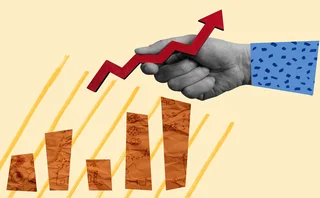
Sponsor's article > Man Group Case Study: Examining External Loss Events for Operational Risk Assessments
Man Group plc is a leading global provider of alternative investment products and solutions, as well as one of the world’s largest futures brokers. In the sectors in which it is active, particularly hedge funds, operational risk is the chief danger the company faces. In order to understand and respond to the many facets of this risk, as well as to hold sufficient capital against possible losses, the company needs information on what might go wrong and what it would cost if it did.
But as a well-managed organization, Man has little internal data on losses to analyze. Therefore, it required an external loss database, and the only product that met its requirements in terms of depth, structure, organization, quality and presentation of information was the Algo OpVantage FIRST database from Algorithmics. Man now uses the database extensively to enhance its risk management and to calculate risk capital.
Man Group employs over 3,000 people in 15 countries, with key centres in London, Pfäffikon (Switzerland), Chicago, New York, Paris, Singapore and Sydney. The company is listed on the London Stock Exchange (EMG.L) and is a constituent of the FTSE 100 Index. The asset management division, Man Investments, is a global leader in the fast growing alternative investments industry, where for the past 20 years it has provided access for private and institutional investors worldwide to hedge fund and other alternative investment strategies. The brokerage division, Man Financial, is a leading provider of brokerage services in futures, options and other equity derivatives for both institutional and private clients, and is an intermediary in the world's metals, energy and foreign exchange markets.
Of the two divisions, it is Man Investments that felt a particularly strong need for external loss data. "We have very little internal loss information in the division, but this is a sector that has something of an aura around it and we are tarnished or shine by the light of that aura," says Jonathan Howitt, operational risk manager at Man Group. "Our reputation is at the heart of our business model, not just for performance but also for integrity. A crisis or big operational event at a hedge fund manager can affect us, so we are very sensitive to what is happening in the outside market."
Also, although Man is confident that it is diligently run, without knowing what has gone wrong at other firms, it is difficult for the risk management team to be aware of all the perils facing the company and to spread this awareness through the relevant areas of the business.
Another difficulty that Man faces as a leading player in an evolving market is keeping up with regulatory attitudes and concerns. "We want to have a good feel of the regulatory mood because regulators are still forming their approach to the hedge fund sector, both in the UK and the US," says Howitt. Regulators will usually become involved in hedge fund loss events because investors are affected. "We need to know what the regulators are currently focused on, or what they want firms to be more diligent about." This applies particularly to product suitability, sales and disclosure risks and, to a lesser degree, systemic risk, such as that caused by the demise of Long-Term Capital Management in 1998, he says.
Although Man had some sources of external loss information, it was not comprehensive, lacked structure, was not risk and compliance focused, and was difficult to access. Not only did risk management require a better data source, but there was also a demand from compliance and internal audit, as well as some business areas, including certain trading desks. A survey of the market revealed that there was just one product that met the company's requirements-the FIRST database from Algorithmics.
"It was the only product with 10-15 years worth of data, organized and categorized, with a depth and rigour of analysis, where the cases are presented with a narrative around the incident," says Howitt. The case studies include incidents of misselling, product suitability, rogue trading, fraud, operational disasters and more.
Other available databases were more quantitative. "One of the problems with these types of databases is that there is always some proprietary element to the information," says Howitt. "They are generally without any narrative around the incidents, or the narrative has been so sanitized by lawyers that there is very little storyline that you can put together." In contrast, FIRST is a collation of public information, including substantial data from regulators, so there is no dispute about its veracity. "And it is not data on its own-it is information in the form of a story that is already in the public domain. Because it is collected, structured and classified properly, we can use it very efficiently," he says.
The FIRST database is straightforward to implement-it is simply a matter of purchasing licenses that allow users to log on, read, search and download. Man took approximately 10 licenses, which was enough for all interested areas of the business to have access-risk, audit, compliance and the chief operating officers of Man in the UK, Switzerland and the US-with risk management in particular sifting that database for relevant information and distributing where appropriate in the company.
"When we first got the database and saw that it contained over 5,000 case studies, we said we can't possibly read all these in a week, so we ranked all the events for sector and material relevance," says Howitt. "We ended up with around 1,000 events that we thought relevant, the majority of which had occurred in the last three years." Howitt and his team further boiled these down to around 100 cases that they believed Man could learn immediate lessons from. "When you read a media article in isolation about a single problem it is not as powerful as reading 40-50 case studies in a single sitting, or being able to see the whole universe of problems, losses, scandals and frauds in the hedge fund sector."
Algorithmics adds new case studies to FIRST continuously as relevant incidents occur in the industry. So how does Man use the existing and new information? Howitt and his team forward case studies that appear relevant to appropriate people within the company. Often, the discussion of the case studies is between risk management and compliance, but where Howitt or one of his colleagues comes across an incident that appears to relate to a particular part of the business where there may be issues similar to those highlighted in FIRST, the case study will be forwarded to the business unit, perhaps with some comments or questions.
"The good thing about the storyline style of writing up losses is that although people don't see themselves exactly in another company, they may be able to see elements that they recognize-areas where there are potential problems that we need to be aware of," says Howitt.
Man invests in around 500 hedge funds in its fund of funds business. To develop this business, the company has a new manager initiative team who perform due diligence on hedge funds in which the company might invest. A lot of hedge funds are quite small companies, many of them new. Statistically, with a universe of 500 or so funds there are bound to be problems from time to time. "So it is very valuable to access FIRST and look at hedge funds that went wrong, and see why they went wrong-whether they were accidents waiting to happen, or whether they were surprises and, if they were, what other people missed in their due diligence," says Howitt.
Howitt and his team usually prepare a short report on relevant losses for the firm's monthly divisional risk committee meetings, and will alert those attending the meetings to case studies that could be relevant to their activities. "The idea is to keep people in the business thinking and make them risk aware so that in their business processes or dealings with third parties they have in mind what can go wrong," says Howitt.
In preparing these reports for meetings, or disseminating the FIRST case study material in other ways around the company, Howitt and his team try to avoid adding subjective comments. Comments that imply that there is the same problem within Man as the one described in the loss event case study, or that force a rigid interpretation of the loss event on recipients of the report, can have a negative impact. "We want to prompt people's thinking rather than pointing a finger, or inferring that they are not running their businesses properly," says Howitt.
"Everybody sees something different in a loss event and it is better to send the article in an open way and let people read it for themselves. It's a bit like art-everyone interprets it differently. We don't want to crush individual and insightful interpretation of the case studies."
FIRST has become a key element in calculating operational risk capital at Man. To calculate the capital that it needs to hold against probable losses, Man uses a scenario-simulation approach. FIRST is now a primary source of information for developing the scenarios and for estimating their potential frequency and impact, providing real-world data on which to base the possible scenarios. "We don't assume that things are going to happen exactly to us exactly like they appear in the database. But FIRST gives us some arms-length, tangible evidence of things that we don't feel we can model accurately. It gives us a better fix on operational risk that we would otherwise be unable to agree on."
Another aspect of FIRST that Man finds helpful is when there is a breaking story that appears of relevance to their business, the company can call Algorithmics for a report. The FIRST research team usually comes back with a response within a day, which saves Howitt and his colleagues having to sit at a computer trying to find out all the pertinent information via an Internet search engine. Furthermore, when the report arrives, it is in a format that is immediately comprehensible. "As risk professionals there is certain context to our job in the way we look at things, the way we categorize risks, the controls that come to mind, and so on. With the FIRST report we are not faced with the task of sifting large amounts of raw information. The report is already organized and categorized for us in a language that I understand," says Howitt.
FIRST is understandably helpful when a loss event occurs outside the company, for example in another jurisdiction, or where there is not much press coverage. Meanwhile, disasters that make the headlines, especially locally, are easier for Man to track for itself. However, so much happens in the financial services industry that even where a loss event is local and well covered by the media, people can quickly forget the details. FIRST provides a quick and easy way of refreshing memories of an event, and identifying the relevant lessons that can be learned.
FIRST has proved helpful to Man in identifying new operational risks as they appear, or where a series of losses suggest there is a cultural problem within a company, or where a risk that is commonplace in one sector rears its head in another. Procter & Gamble's successful lawsuit against Bankers Trust in the US in the 1990s for misselling a derivatives product is a classic example of certain risks-in this case, misselling and relationship risk-that were familiar in the fund management sector suddenly appearing in the wholesale banking area.
FIRST also highlights where a risk is on the rise, such as the growth of identity theft, or intellectual property issues, or employee lawsuits, which have all increased since 2000.
The database is also helpful in tracking the evolving concerns of regulators. The UK's Financial Services Authority's pursuit of the fund management industry from 2001 over the unsuitability of so-called split capital investment trusts for end investors is an example of where a regulator revealed a new approach in interpretation of liability for the sale of unsuitable products. "FIRST was a gold mine of information on this-which companies were affected, what the regulators were saying, etc. It was all in one place," says Howitt.
FIRST is also helpful to Man in getting a better assessment of the possible scale of losses with a particular problem. "We might have a problem and suffer a small loss and internal management might think that it is not material and think we couldn't lose very much, but FIRST might show that this is not the case at other firms and cause us to have a rethink," says Howitt.
FIRST also offers good lessons in how not to respond to a problem when it arises, says Howitt. Case studies in the database document the responses of firms to crises, and highlight where their approach only made matters worse, provoking regulators, the media, investors or others, and increasing losses and/or damage to reputation. For example, Putnam Investments' denial of a problem in the market timing scandal in the US in 2004, and its subsequent handling of the issue, led to a massive withdrawal of funds from the company-over $50 billion in three months.
Howitt says that the coverage of FIRST continues to improve, with case studies now covering continental Europe and Asia, as well as the UK and US. The inclusion of some case studies where there is no detail of the actual losses a company might have suffered are nevertheless useful because they often highlight reputational issues where it can be difficult to quantify the damage. Also, occasional non-financial sector case studies have proved relevant because they generally highlight a universal problem, such as data security.
"FIRST is put together by people who clearly understand the financial sector, understand risk and are interested in the problems," says Howitt. The taxonomy of the information is appropriate, and recognizes the categories used in the Basel II capital adequacy regulations.
Man hasn't quantified the return on investment in FIRST. "It's preventative medicine-how do you quantify that?" asks Howitt. "Our view is that it is worth spending a bit of money to raise awareness and thereby reduce the likelihood of problems. It's hard to quantify what it is worth, but by any metric it is value for money."
"FIRST is a very powerful tool to alert management to some of the underlying business and reputational risks that we could become embroiled in. No matter how diligent or innocent we are, we can still be embroiled in a problem by just existing in the sector," says Howitt.
"The mark-to-market of information is very volatile. No one is interested in information until they need it, and then it's worth a fortune. The benefit of FIRST is that the information is all there when you need it - you don't have to go and fish ad hoc for it," he says.
AlgorithmicsOnly users who have a paid subscription or are part of a corporate subscription are able to print or copy content.
To access these options, along with all other subscription benefits, please contact info@risk.net or view our subscription options here: http://subscriptions.risk.net/subscribe
You are currently unable to print this content. Please contact info@risk.net to find out more.
You are currently unable to copy this content. Please contact info@risk.net to find out more.
Copyright Infopro Digital Limited. All rights reserved.
As outlined in our terms and conditions, https://www.infopro-digital.com/terms-and-conditions/subscriptions/ (point 2.4), printing is limited to a single copy.
If you would like to purchase additional rights please email info@risk.net
Copyright Infopro Digital Limited. All rights reserved.
You may share this content using our article tools. As outlined in our terms and conditions, https://www.infopro-digital.com/terms-and-conditions/subscriptions/ (clause 2.4), an Authorised User may only make one copy of the materials for their own personal use. You must also comply with the restrictions in clause 2.5.
If you would like to purchase additional rights please email info@risk.net
More on Markets
FXGO volumes surge despite fee switch-on
Dealers split on whether levy is behind volume increases across SDPs
Banks hope new axe platform will cut bond trading costs
Dealer-backed TP Icap venture aims to disrupt dominant trio of Bloomberg, MarketAxess and Tradeweb
Kyriba sees uptake in AI-assisted FX hedging tools
Automated data collection and cleaning helps corporates create better hedges and has cut unexplained P&L moves by 87%, says vendor
Review of 2025: It’s the end of the world, and it feels fine
Markets proved resilient as Trump redefined US policies – but questions are piling up about 2026 and beyond
Does crypto really need T+0 for everything?
Instant settlement brings its own risks but doesn’t need to be the default, writes BridgePort’s Soriano
Asset managers prep autocall ETFs with assets tipped to hit $30bn
Actively managed strategies wait in the wings after systematic approach nets Calamos $500m
Citi launches core inflation QIS
Custom indexes eliminate energy and food prices to ease trading of stickier inflation trends
US insurers turn to short-dated FX forwards as notionals rise
Counterparty Radar: Trades under three months make up nearly 60% of total positions, up from just a third in 2022







